| |||||||||||||||||||||||||||||||||||||||||
| [Source] | |||||||||||||||||||||||||||||||||||||||||
The Sol system (Solar system) is the gravitationally bound system comprising of the single Sol and the objects that orbit it. The Sol System has a relatively interesting composition, with a yellow dwarf star, 4 terrestrial planets, a belt, 2 gas giants, 2 ice giants, a belt of icy objects, an eccentric ice giant, a dense belt of icy objects which merges into a cloud of comets. The Conglomerate has named all celestial objects bound to the system after Roman mythology of Terra. This ranges from titans in the Titan belt, to the major gods, assigned to planets and major moons, and the minor deities such as nymphs were assigned to asteroids, comets, minor moons, or other small objects. Any object left over was named after their discoverers or notable people. This system holdsTerra, the cradle of Humanity and the capital of the Conglomerate. Of the objects that orbit Sol directly, the largest nine are the planets, with the remainder being significantly smaller objects, such as dwarf planets and small bodies which grow in number the smaller the size criteria gets. Of the objects that orbit the Sol indirectly, the moons, two are larger than the smallest planet, Mercury.
The vast majority of the system's mass is in Sol, with most of the notable remaining mass contained in Jupiter and Pluto. The four smaller inner planets, Mercury, Venus, Terra and Mars, are terrestrial planets, being primarily composed of rock and metal. Their orbits extend from 0.38 AU to 1.5 AU. This is where the population of the system is most densely populated. Terra is the main planet of the system, and is where the majority of the population is centered. The gate to the outer Sol system, a nickname for the Argusian Belt, is a belt of stony asteroids, kept from accreting into a planet by Jupiter. The belt only has one dwarf planet, Flora. Lying between the orbits of Jupiter and Mars, the belt is home to less than 1 billion humans, most of which live in the largest 5 objects in the Argusian belt. Although inhabited, the vast majority of asteroids in this belt are far too small for habitation.
The six outer planets are giant planets, being substantially more massive than the terrestrials. The two largest, Jupiter and Pluto, are gas giants, being composed mainly of hydrogen and helium; the three outermost gaseous planets, Ceres, Neptune, and Janus are ice giants, being composed mostly of substances with relatively high melting points compared with hydrogen and helium, and called ices, such as water, ammonia and methane. The outermost planet, Janus, is an ice giant which was ejected by Jupiter and Pluto early on in the Sol system's formation. There is the Titan Belt, between Neptune and Janus. This belt contains the most amount of dwarf planets. The two largest are Saturn and Caelus. Both Neptune and Janus affect the Titan Belt, ejecting objects in a specific resonance. Janus is also responsible for the Titan Cliff, a cutoff in the Titan Belt at 48 AU.
Past Janus, there is the Carpo Belt which gradually merges into the larger, but less dense Herculean Cloud at 23,000 AU from Sol. Within the Carpo Belt there are four major objects: Vesta, Cupid, Bellona, and Terminus. Dwarf planets are rare due to the vast distances between objects in the Carpo Belt and more so in the Herculean Cloud.
Many scientists and astronomers are certain another planet was orbiting Sol early on, Catamitus. It is now a rouge planet located about 963 light-years from this system. Catamitus was probably responsible for the Late heavy bombardment and was ejected from the system by Jupiter.
Objects in the Herculean Cloud are known to be subject to Galactic tides and passing stars, bound to be lost to the void of interstellar space eventually, and is thus, sparsely populated compared to the Carpo Belt. The Sol System is located in the Orion Spur, about 27,200 light-years from the center of the Milky Way.
The principal component of the Sol system is Sol, a G class main-sequence star that contains 99.86% of the system's known mass and dominates it gravitationally. Sol's four largest orbiting bodies, the giant planets, account for 99% of the remaining mass, with Jupiter and Pluto together comprising more than 90%. The remaining objects of the Sol system (including the four terrestrial planets, the dwarf planets, moons, asteroids, and comets) together comprise less than 0.002% of the Sol system's total mass.
Most large objects in orbit around Sol lie near the plane of Terra's orbit, known as the ecliptic. The planets are very close to the ecliptic, whereas comets and Titan belt objects are frequently at significantly greater angles to it. All the planets and most other objects orbit Sol in the same direction that Sol is rotating (counter-clockwise, as viewed from above Terra's north pole).
Most of the planets in the Sol system possess secondary systems of their own, being orbited by planetary objects called natural satellites, or moons (two of which are larger than the planet Mercury), and, in the case of the four giant planets, by planetary rings, thin bands of tiny particles that orbit them in unison. Most of the largest natural satellites are tidally locked, with one face permanently turned toward their parent.
Sol, which comprises nearly all the matter in the Sol system, is composed of roughly 98% hydrogen and helium. Jupiter and Pluto, which comprise nearly all the remaining matter, possess atmospheres composed of roughly 99% of these elements. The boundary in the Sol system beyond which those volatile substances could condense is known as the frost line, and it lies at roughly 5 AU from Sol.
The nine planets of the Sol system (by decreasing size) are Jupiter, Pluto, Ceres, Neptune, Janus, Terra, Venus, Mars and Mercury. The distance from Terra to Sol is 1 astronomical unit (150,000,000 km), or AU. Jupiter, the largest planet, is 5.2 astronomical units (780,000,000 km) from Sol and has a radius of 71,000 km (0.00047 AU), whereas the most distant planet, Janus, is 702.12 AU (105,035,700,000 km) from Sol.
| Sol System | |||||||
|---|---|---|---|---|---|---|---|
| Name | Mass | Radius | Semi-major axis (AU) | Orbital period (Days) | Eccentricity | Inclination | Objects R > 1000 km |
| Mercury | 0.05 ⊕ | 0.38 ⊕ | 0.387 | 87.96 | 0.205 | 7° | 0 |
| Venus | 0.815 ⊕ | 0.9499 ⊕ | 0.723 | 224.7 | 0.006 | 3.39° | 0 |
| Terra | 1 ⊕ | 1 ⊕ | 1 | 365.25 | 0.016 | 0° | 1 |
| Mars | 0.107 ⊕ | 0.532 ⊕ | 1.523 | 686.97 | 0.093 | 1.85° | 0 |
| Argusian Belt | 2.06 — 4.2 | 1,079.75 — 3,143.39 | 0 | ||||
| Jupiter | 1 ♃ | 1 ♃ | 5.202 | 4,332.59 | 0.048 | 1.303° | 4 |
| Pluto | 0.299 ♃ | 0.832 ♃ | 9.554 | 10,759.22 | 0.055 | 2.485° | 1 |
| Ceres | 0.847 ♆ | 1.03 ♆ | 19.218 | 30,688.5 | 0.046 | 0.773° | 0 |
| Neptune | 1 ♆ | 1 ♆ | 30.11 | 60,182 | 0.009 | 1.767° | 1 |
| Titan Belt | 39.4 — 48 | 90,316.7 — 121,447 | 0 | ||||
| Janus | 0.631 ♆ | 0.94 ♆ | 702.128 | 6,793,950 | 0.702 | 30.147° | 0 |
| Carpo Belt | 919 — ≈25,000 | 10,174,100 — ≈1,443,560,000 | 0 | ||||
| Herculean Cloud | ≈25,000 — ≈150,000 | ≈1,443,560,000 — ≈21,215,900,000 | 0 | ||||
Composition[]
In this list, stars, planets, belts, large moons, and any object over 1,000 km in radius is included.
- Sol
- Mercury (Mercury)
- Venus (Venus)
- Aeneas Ring
- Terra (Earth)
- Mars (Mars)
- Argusian Belt (Asteroid belt)
- Jupiter (Jupiter)
- Pluto (Saturn)
- Ceres (Uranus)
- Neptune (Neptune)
- Titan Belt (Kuiper belt)
- Caelus (Eris)
- Janus (Planet Nine)
- Carpo Belt (Hills cloud)
- Herculean Cloud (Oort cloud)
Sol[]

Sol, the only star of the Sol System
Sol is the Sol system's only star and by far its most massive component. Its large mass (332,900 Earth masses) produces temperatures and densities in its core high enough to sustain nuclear fusion of hydrogen into helium, making it a main-sequence star. This releases an enormous amount of energy, mostly radiated into space as electromagnetic radiation peaking in visible light.
Sol is a G2-type main-sequence star of population I. Hotter main-sequence stars are more luminous. Sol's temperature is intermediate between that of the hottest stars and that of the coolest stars. Stars brighter and hotter than Sol are rare, whereas substantially dimmer and cooler stars, known as red dwarfs, make up 85% of the stars in the Milky Way. It has a higher abundance of elements heavier than hydrogen and helium than the older population II stars. This high metallicity is thought to have been crucial to Sol's development of a planetary system because the planets form from the accretion of "metals".

Mercury, the closest planet to Sol
Mercury[]
Mercury is the closest planet to Sol and the smallest planet in the Sol system . Mercury has no natural satellites. Its relatively large iron core and thin mantle was caused by both its outer layers were stripped off by a giant impact and was prevented from fully accreting by the young Sol's energy.
Venus[]
Venus is close in size to Terra and, like Terra, has a thick silicate mantle around an iron core, a substantial

Venus, formerly the hottest planet
atmosphere, and evidence of internal geological activity. It is much drier than Terra, and its atmosphere is ninety times as dense. Venus has no natural satellites. It is the hottest planet, with surface temperatures over 400 °C (752°F), most likely due to the amount of greenhouse gases in the atmosphere. Venus has long since been terraformed, with most of it's atmosphere being shipped off world to other terraforming missions. Terraformed Venus had 80% of it's surface area, is the tropical planet of the Sol system, and supports a population of eight billion.

Terra, the homeworld of Humanity
Terra (Earth)[]
Terra is the largest and densest of the inner planets, the only one known to have current geological activity, and the the homeworld of Humans. Its liquid hydrosphere is unique among the terrestrial planets, and it is the only planet where plate tectonics has been observed. Earth's atmosphere is radically different from those of the other planets, having been altered by the presence of life to contain 21% free oxygen. It has one natural satellite, Luna, the only large satellite of a terrestrial planet in the Sol system. About 71% of it's surface is covered by liquid water and has a population of 14 billion.

Luna, one of the largest moons in the system
Luna (Moon)[]
Luna is Terra's only natural satellite. It is one of the largest natural satellites in the Solar System, and, among planetary satellites, the largest relative to the size of the planet it orbits (its primary). It is the second-densest satellite among those whose densities are known (after Jupiter's satellite Vulcan).
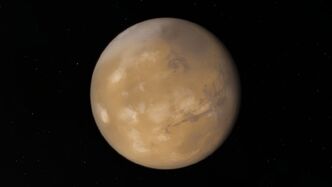
Mars, the outermost inner planet
Mars[]
Mars is smaller than Terra and Venus. It possessed an atmosphere of mostly carbon dioxide with a surface pressure of 6.1 millibars (roughly 0.6% of that of Terra). Its surface, peppered with vast volcanoes, such as Olympus Mons, and rift valleys, such as Valles Marineris, shows geological activity that may have persisted until as recently as 2 million years ago. Its former red colour comes from rust in its soil. Mars has two tiny natural satellites thought to be captured asteroids. Along with Venus, Mars is one of the few worlds to be terraformed in the Sol system. Terraformed Mars has about 35% of it's surface covered by water and supports a population of six billion.
Argusian Belt (Asteroid Belt)[]
Asteroids except for the largest, Flora, are classified as small bodies and are composed mainly of refractory rocky and metallic minerals, with some ice. They range from less than a metre to hundreds of kilometres in size. Asteroids smaller than one meter are usually called meteoroids and micrometeoroids (grain-sized). The belt occupies the orbit between Mars and Jupiter, between 2.06 and 4.2 AU from Sol. It is thought to be remnants from the Sol system's formation that failed to coalesce because of the gravitational interference of Jupiter.

Jupiter, the largest planet
Jupiter[]
Jupiter, at 318 Terra masses, is 2.5 times the mass of all the other planets put together. It is composed largely of hydrogen and helium. Jupiter's strong internal heat creates permanent features in its atmosphere, such as cloud bands and the Great Red Spot. Jupiter has 67 known satellites. The four largest, Juno, Bacchus, Vulcan, and Minerva, show similarities to the terrestrial planets, such as volcanism and internal heating. Juno, the largest satellite in the Sol system, is larger than Mercury.
Vulcan (Io)[]

Vulcan, the most volcanic object in the system
Vulcan is the innermost of Jupiter's moons. It is the fourth-largest moon, has the highest density of all the moons, and is the driest known object in the Sol system. With over 400 active volcanoes, Vulcan is the most geologically active object in the Sol system. This extreme geologic activity is the result of tidal heating from friction. As a result of this, Vulcan is also the driest known object in the Sol System.
Minerva (Europa)[]

Minerva, a rare oceania moon
Minerva is the second-closest major moon of Jupiter, and the smallest of its four major satellites, but still the eighth-largest moon in the Sol system. It has the smoothest surface of any known solid object in the Sol system. The moon is an oceania, with a subsurface ocean dozens of kilometers deep, kept liquid by tidal heating; the same effect that makes Vulcan volcanic. Although life is possible in Minerva's subsurface ocean, no trace of life has been found.
Juno (Ganymede)[]

Juno, the largest moon in the system
Juno is the largest moon of Jupiter and in the Sol system, and the only moon known to have a natural magnetosphere. It is the third outermost major moon, orbits Jupiter in roughly seven days and is in a 1:2:4 orbital resonance with Minerva and Vulcan, respectively. Juno has a diameter of 5,268 km (3,273 mi), 8% larger than Mercury, but its mass is only 45% that of Mercury. It is the largest object in the Sol system without a substantial atmosphere.
Juno is composed of approximately equal amounts of silicate rock and water ice. It is a fully differentiated body with an iron-rich, liquid core, and an internal ocean that contains more water than all of Terra's oceans.
Bacchus (Callisto)[]

Bacchus, the oldest surface in the system
Bacchus is the third-largest moon in the Sol system and the second largest in the Jovian system, after Juno. At 4821 km in diameter, Bacchus has about 99% the diameter of Mercury but only about a third of its mass. It is the fourth major moon of Jupiter by distance. It is not part of the orbital resonance that affects three inner Jovian satellites—Vulcan, Minerva and Juno—and thus does not experience appreciable tidal heating. It is less affected by Jupiter's magnetosphere than the other inner satellites because of its more remote orbit, located just outside Jupiter's main radiation belt. Bacchus, like Juno and Minerva, has a subsurface ocean over 100 km in depth. The surface of Bacchus is the oldest and most heavily cratered in the Sol system.
Pluto (Saturn)[]
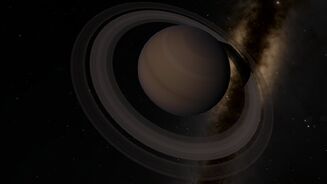
Pluto, the least dense planet
Pluto, distinguished by its extensive ring system, has several similarities to Jupiter, such as its atmospheric composition and magnetosphere. It has the most expansive ring system of all planets in the system, with Janus coming in 2nd. Although Pluto has 60% of Jupiter's volume, it is less than a third as massive, at 95 Terra masses, making it the least dense planet in the Sol system. The rings of Pluto are made up of small ice and rock particles. Pluto has 62 confirmed satellites; two of which, Proserpina and Silvanus, show signs of geological activity, though they are largely made of ice. Proserpina, the second-largest moon in the Sol system, is larger than Mercury and the only satellite in the Sol system with a substantial atmosphere.
Proserpina (Titan)[]

Proserpina, the only moon with a notable atmosphere in the system
Proserpina is the largest moon of Pluto. It is the only natural satellite known to have a dense atmosphere, and the only object in the system other than Terra where stable bodies of surface liquid has been found. Proserpina's diameter is 50% larger than Terra's natural satellite, Luna, and it is 80% more massive.
The atmosphere of Proserpina is largely nitrogen; minor components lead to the formation of methane–ethane clouds and nitrogen-rich organic smog. The climate—including wind and rain—creates surface features similar to those of Terra, such as dunes, rivers, lakes, seas, and deltas, and is dominated by seasonal weather patterns as on Terra. With its liquids (both surface and subsurface) and robust nitrogen atmosphere, Proserpina's methane cycle is analogous to Terra's water cycle, although at a much lower temperature.
Ceres (Uranus)[]

Ceres, which has a tilt perpendicular to its orbit
Ceres is the seventh planet from Sol. It has the third-largest planetary radius and fourth-largest planetary mass in the Sol system. It is an ice giant, similiar in composition to Neptune and Janus rather than Jupiter and Pluto.
Like the other giant planets, Ceres has a ring system, a magnetosphere, and numerous moons. The Ceres has a unique configuration among those of the planets because its axis of rotation is tilted sideways, nearly into the plane of its revolution about Sol. Its north and south poles therefore lie where most other planets have their equators. Ceres has major seasonal change, seen with increased weather activity as Ceres approaches its equinoxes. Wind speeds can reach 250 metres per second (900 km/h, 560 mph).
Neptune[]

Neptune, the largest ice giant of the system
Neptune is the eighth from Sol in the Sol system. It is the fourth-largest planet by diameter and the third-largest by mass. Neptune is similar in composition to Ceres, and both have compositions that differ from those of the larger gas giants, Jupiter and Pluto. In contrast to the hazy, relatively featureless atmosphere of Ceres, Neptune's atmosphere has active and visible weather patterns. Neptune has the strongest weather patterns of the system. Driven by the strongest sustained winds of any planet in the Sol system, with wind speeds as high as 2,100 kilometres per hour (580 m/s; 1,300 mph).
Triton[]
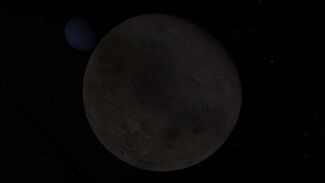
Triton, the only major moon in a retrograde orbit
Triton is the largest natural satellite of Neptune. It is the only large moon in the Sol system with a retrograde orbit, an orbit in the opposite direction to its planet's rotation. At 2,700 kilometres (1,700 mi) in diameter, it is the seventh-largest moon in the Sol system. Because of its retrograde orbit and composition similar to Saturn's, Triton was probably a dwarf planet captured from the Titan Belt.
Titan Belt (Kuiper Belt)[]
The Titan Belt is a circumstellar disc in the Sol system beyond the main set of planets, extending 30 to 48 AU from Sol. It is similar to the Argusian Belt, but it is far larger—20 times as wide and 20 to 200 times as massive. Like the Argusian Belt, it consists mainly of small bodies, or remnants from the Sol system's formation. Although many asteroids are composed primarily of rock and metal, most objects are composed largely of frozen volatiles (termed "ices"), such as methane, ammonia and water. The Kuiper belt is home to several large dwarf planets, two of the largest are Saturn and Caelus
The belt was initially thought to be the main repository for periodic comets, those with orbits lasting less than 200 years. However, the belt is dynamically stable, and that comets' true place of origin is the scattered disc, an extension of the Titan Belt and dynamically active zone created by the outward motion of Neptune 4.5 billion years ago; scattered disc objects such as Caelus have extremely eccentric orbits that take them as far as 100 AU from Sol.
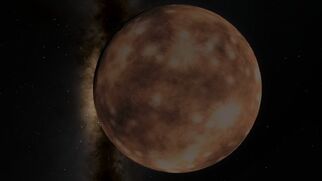
Saturn, which is part of a double dwarf planet system
Saturn (Pluto)[]
Saturn is a dwarf planet in the Titan Belt, a ring of bodies beyond Neptune. It is the largest known Titan Belt object by volume but is less massive than Caelus. Like other Titan Belt objects, Saturn is primarily made of ice and rock. It has a moderately eccentric and inclined orbit during which it ranges from 30 to 49 astronomical units or AU (4.4–7.4 billion km) from Sol.
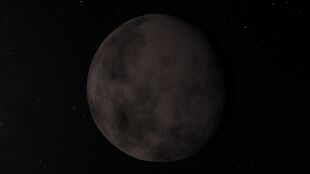
Caelus
Caelus (Eris)[]
Caelus is measured to be 2,326 kilometers (1,445.3 miles) in diameter. Caelus is 27% more massive than dwarf planet Saturn, though Saturn is slightly larger by volume. Eris's mass is about 0.27% of the Terra's mass. It was originally in the Titan Belt, but was ejected by Neptune and placed into an orbit triple that of Neptune.
Janus (Planet Nine)[]

Janus
Janus (Planet Nine) is the last planet from Sol. It has the fifth-largest planetary radius and mass in the Sol System. Janus is similar in composition to Neptune and Ceres, as they all have different bulk chemical composition from that of the larger gas giants Jupiter and Pluto. Janus is near the limit considered for an ice giant. Although similar to Jupiter's and Pluto's in its primary composition of hydrogen and helium, contains more "ices", such as water, ammonia, and methane, along with traces of other hydrocarbons. It is the coldest planetary atmosphere in the Solar System, with a minimum temperature of 14 K (-259.15 °C). This is about the freezing temperature of hydrogen. The interior of Janus is mainly composed of ices and rock. This planet is named after the Roman god of transitions, beginning and endings.
Carpo Belt (Hills Cloud)[]
The Carpo Belt (Hills cloud) is the 3rd circumstellar disk from Sol. It is many times larger than the Titan Belt and is interior to the Herculean Cloud. Objects orbiting in this belt are mostly icy, although there are several rocky, major objects. The Carpo Belt is faintly influenced by Janus, the 9th planet from Sol. However, due to the vast distances, this effect is extremely minimal and is not comparable to the control Jupiter has on the Argusian Belt or Neptune to the Titan Belt.
Herculean Cloud (Oort Cloud)[]
The Herculean Cloud (Oort cloud), is a circumstellar cloud of Sol of the Sol system. The objects in this cloud are frequently victim to passing stars, being stolen from their parent. The cloud merges into the Carpo Belt at 25,000 AU from Sol, and ends at the end of Sol's Kudrin sphere, at about 2.38 light-years, or roughly 150,500 AU. In contrast to the other circumstellar disks, the Herculean Cloud is spherical, rather than a torus. Due to the extreme distance from the main system, and nothing of value in these reaches of the Sol system, there are no colonies and ships virtually never travel to these parts of the Sol system; with the exception of the occasional science mission. In fact, even at light-speed, it takes light 4.7 months to reach the inner-edge of the Herculean Cloud, making travel expensive and unprofitable.